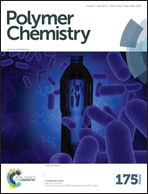Synthesis of a new poly([R]-3-hydroxybutyrate) RAFT agent†
Abstract
Poly[(R)-3-hydroxybutyrate] (PHB) has attracted more and more attention in biomedical applications in recent years, due to its excellent properties of sustainability, biodegradability and biocompatibility. In this work, purified natural PHB was modified by 1-hexanol through transesterification reaction to form mono-hydroxylated PHB. The kinetic process of transesterification was carefully investigated. The mono-hydroxylated PHB was reacted with the thiocarbonylthio compound to generate a biodegradable macro mono-hydroxylated PHB chain transfer agent (CTA), which could react with other monomers to produce block copolymers. The monomer, 2-dimethylaminoethyl methacrylate (DMAEMA) was chosen to demonstrate the copolymerization process and the block copolymer PHB-b-PDMAEMA was obtained.
![Graphical abstract: Synthesis of a new poly([R]-3-hydroxybutyrate) RAFT agent](/en/Image/Get?imageInfo.ImageType=GA&imageInfo.ImageIdentifier.ManuscriptID=C5PY01812A&imageInfo.ImageIdentifier.Year=2016)

 Please wait while we load your content...
Please wait while we load your content...